
In this guide, I will demonstrate how to deploy a domain controller in Azure.
Deploying a Domain Controller in Azure can be used to add additional Domain Controllers to your on-premises environment. It’s also an easy way to create an Active Directory test lab.
Note: The VM I create in this demo is for testing, the settings are not optimal for a production domain controller. If you want to deploy a Domain Controller in Azure for production you will need to determine the right settings for your organization, such as VM size (CPU, Mem), redundancy options, disks, and network settings, all of which will increase the cost.
Tip #1: For a production DC, DO NOT give it a public IP or allow public inbound ports.
Tip #2: To add an azure domain controller to your on-premises environment you will need a VPN tunnel from your network to Azure. I will go over this in a separate guide.
Tip #3: For production, the Azure virtual network must not overlap your on-premises network. For testing, it doesn’t matter (assuming you will not be connecting to your on-premises network).
Let’s get started.
Part 1: Create a Virtual Machine
If you don’t have an Azure account you can create one for free. Microsoft gives you a $200 Azure credit for 30 days. This is plenty of credits to create several VMs and use other Azure resources.
Step 1. Sign in to your azure portal, https://portal.azure.com
Step 2. Click on “Virtual machines”
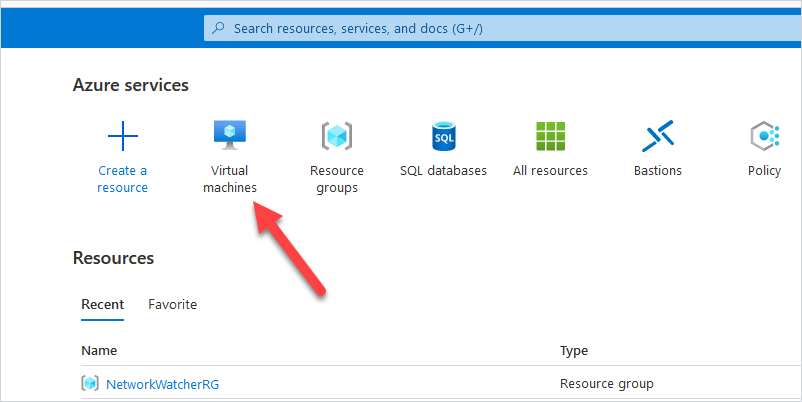
Step 3. Click on Create and select “Azure virtual machine”
Step 4. Enter basic information for the new VM
- Subscription: Select the subscription you want to use for the VM.
- Resource group: Select an existing or create a new resource group.
- Virtual machine name: Give your VM a name.
- Region: Choose your region, you typically want a region that is close to you.
- Availability options: This is for redundancy and will ensure your VMs are still running if one Azure data center has a failure. You want this for production VMs. I’m just creating a test VM so I’ll choose “No infrastructure redundancy required.”
- Security Type: I’ll choose Standard.
- Image: Pick the OS you want to use, I’ll pick “Windows Server 2019 Datacenter”.
- Size: You will need to determine the size of VM you need. For testing reasons, I’ll choose a small VM to keep costs low.
- Username and password: This will be the administrator account for the VM.
- Public inbound ports: For production, you want this set to “none”. For testing, I’ll leave RDP open.
- Licensing: If you have an existing license you can use select the box, this can save money on each VM.
Here is a screenshot of the Basics settings for my VM.

Now click Next to go to the Disks page.
Step 5. Enter disk details for the VM.
Determine the disk type to use, for testing I use the standard HDD.
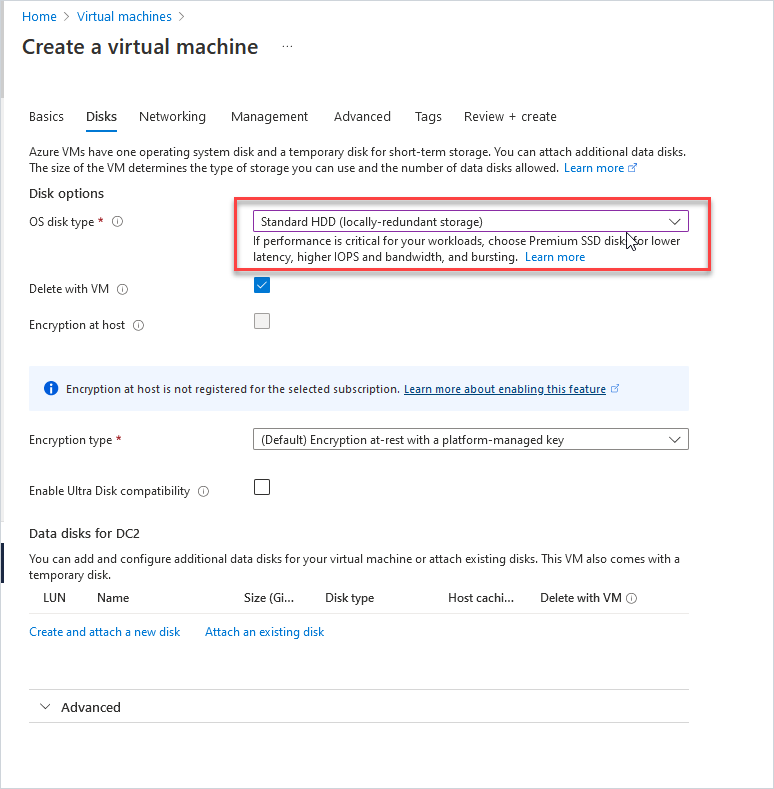
Click next to go to networking.
Step 6. Network settings
- Virtual network: Select an existing or create a new virtual network.
- Subnet: Select or create a subnet.
You create a virtual network and then use subnetting to segment the address space. For example, I’m using the 10.1.0.0/16 address space then I segment 10.1.10.0/24 (256 addresses) with subnetting. I’ll use the 10.1.10.0/24 subnet block for my servers.
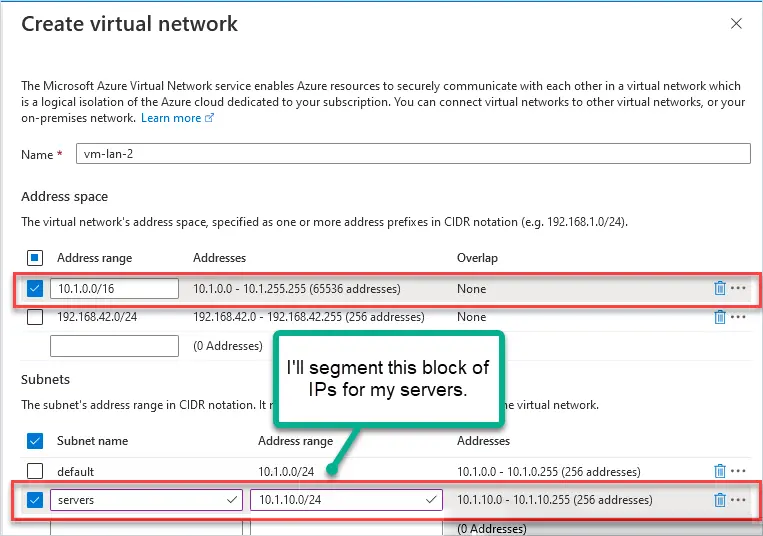
- Public IP: A public IP will be added automatically. For testing, this is OK, for production set this to none.
- NIC network security group: This is s stateful firewall for your virtual network. I’ll choose standard.
- Public inbound ports: For production, you want to select none. For testing, you can use RDP to access the VM.
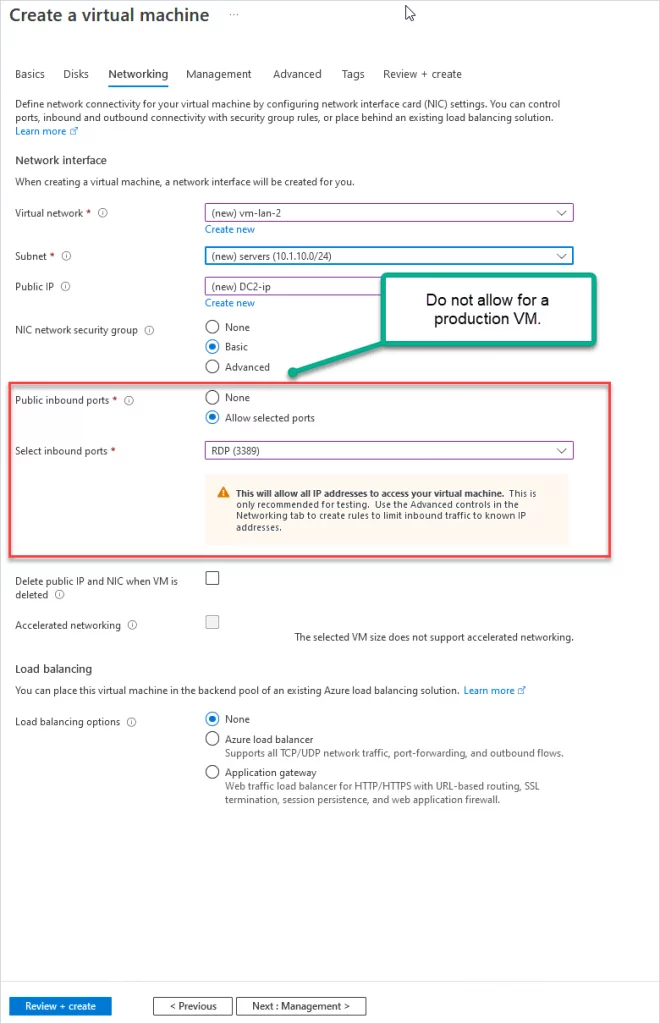
Click next to “Management”
Step 7: Management Settings
The only thing I want to point out on this page is the “Auto-shutdown” option. For testing with Azure, this is a great feature to help save costs. You get charged for the VM running even if you are not using it. I’m not going to be using this test domain controller 24/7 so I’ll have it auto shut down at 7:00 PM each night. Do not do this for a production domain controller.
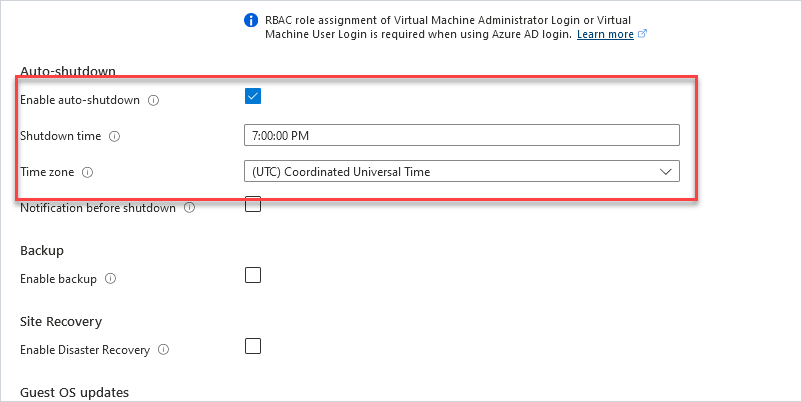
Step 8: Click Review + create
Microsoft will validate your settings and show any warnings or settings that were missed. You will also get a cost estimate but keep in mind it is just an estimate.
When ready click the “Create” button to create the VM.
You will get a progress page so you can watch the status of the deployment. It took about 5 minutes for my VM to be created.
Part 2: Configure VM with Static IP Addresses
Domain controllers need a static IP address and the DNS pointing to itself. For on-premises DCs you would just go into the NIC settings and manually configure the IP settings. With Azure VMs it’s recommended to set this at the Virtual Network Interface.
Go to VM Networking settings.
In the right-hand menu for your VM under settings click on “Networking”.
Now click on the Network Interface for the VM (You will have a different name).
Next click on “IP Configurations” in the left menu under settings.
Next click on “ipconfig1” under IP configurations.
Change the IP from “Dynamic” to “Static” and enter the IP address you want the domain controller to have, it must be an IP from the subnet you assigned to your virtual network. I’ll give my DC the IP address 10.1.10.10.
Click “Save”. The network interface will be restarted to set the IP address.
Go back to the Network Interface and click on “DNS servers”.
Set the DNS server to the IP address of the domain controller.
Now on the VM, your server should be configured with the settings from above. Below I run ipconfig /all to verify my IP settings.
Part 3: Install Active Directory Domain Services
With a VM created and the IP settings configured we can move forward with installing Active Directory on the server. If you have installed ADDS before this is not new, it’s the same as installing it on an on-premises server.
Go to the server manager and click on “Add roles and features”
Before you begin – click “Next”.
Installation type – select “role based” and click “Next”.
Server Selection – select the hostname of your server and click “Next”.
Server Roles – select “Active Directory Domain Services”.
You will get a pop-up to add additional features. Click “Add Features”.
Click “Next”.
Features – no features need to be added so click “Next”.
AD DS – Click “Next”.
Confirmation – Click “Install”.
The installation will start.
When finished click the yellow icon in the upper right corner and click on “Promote this server to a domain controller”.
Deployment Configuration
I’m creating a new domain so I’m going to pick “Add a new forest”. If you’re adding another DC to your existing domain you would pick the first option “Add a domain controller to an existing domain”.
Domain Controller Options
For a new test domain, the default settings are good. Add a DSRM password and click next.
DNS Options
Click next on this screen.
Additional Options
Enter a NetBIOS name and click “Next”
Paths
I always leave these as default settings
Review Options
Review your settings and click “Next”
Prerequisites Check
If the Prerequisites pass click on “Install”
When done installing the server will reboot and will now be a domain controller.
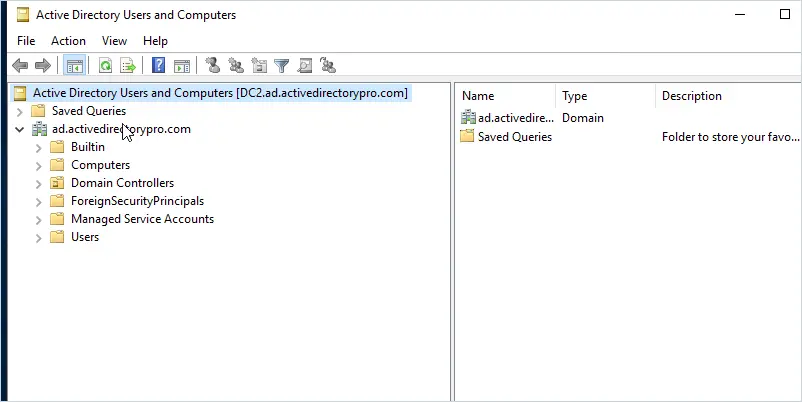
Nice work. If you followed along you should now have a domain controller running in the Azure cloud.
You can now deploy additional Azure VMs and connect them to this domain controller. You can also use this domain controller to add additional DCs to your on-premises environment.
Part 4: Additional Settings and Tips
Here are a few additional settings and tips I recommend.
- You will need to create a new site in Active Directory Sites & Services with the new subnet.
- You should adjust the domain controller DNS settings for redundancy.
- A VPN tunnel is required from your on-premises network to Azure.
- If you are testing and use a public IP with open ports (RDP 3389), then I recommend using fake/dummy data in Active Directory. Their server might get comprised due to the internet exposure so don’t use real data such as real usernames and passwords.
- You can use the Azure firewall to limit access to the VM from your IP address.
- Use Bastion for secure remote connectivity.
- Explore the many options that Azure has to offer, it’s very impressive everything it has to offer.
Do you plan to use domain controllers running in Azure? Let me know in the comments below.
Resources
- Deploy AD DS in an Azure virtual network – Microsoft document with some good details on extended on-premises to Azure.
- How to Add a Secondary Domain Controller
Recommended Tool: Permissions Analyzer for Active Directory
This FREE tool lets you get instant visibility into user and group permissions and allows you to quickly check user or group permissions for files, network, and folder shares.
You can analyze user permissions based on an individual user or group membership.
This is a Free tool, download your copy here.

8 thoughts on “How to Deploy a Domain Controller in Azure”
Source :
https://activedirectorypro.com/deploy-domain-controller-azure/